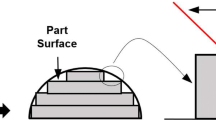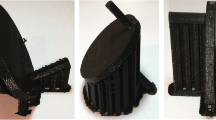Abstract
Orientation determination is an essential process planning task in additive manufacturing (AM) since it directly affects the part quality, part texture, mechanical properties, build time, fabrication cost, etc. Evaluation method provides a simple and effective way to determine the optimum orientation of a part. However, the candidates are predesigned in the evaluation method, which results in limited candidate space and makes the qualities of evaluation results highly dependent on the qualities of the predesigned candidates; bad outcomes will be obtained due to the poor candidates. To this end, a feedback multi-attribute decision-making (MADM) model is proposed in this work. The feedback MADM model is an integration of two sub-models: MADM model and proportional-integral-derivative (PID) control model. MADM model aims to calculate the score of a given build orientation. Three criteria, surface roughness, support volume, and build time, are considered in this model, and the ordered weighted averaging (OWA) operator is applied for aggregation. In the PID control model, the finite candidate space is first expanded to infinity by quaternion rotation, then PID controller is applied to match the build orientation with the user’s requirements, that is, search for the part orientation whose score is consistent with the user expected score in the infinite alternative orientations. Four parts with different geometric structures are tested in the experiments, and evaluation and control features of the feedback MADM model are discussed.
Similar content being viewed by others
References
Gibson I, Rosen DW, Stucker B (2010) Additive manufacturing technologies: rapid prototyping to direct digital manufacturing. Springer, Boston
Zegard T, Paulino GH (2016) Bridging topology optimization and additive manufacturing. Struct Multidiscip Optim 53(1):175–192
Kuo CC, Chen WH, Li JF, Zhu YJ (2018) Development of a flexible modeling base for additive manufacturing. Int J Adv Manuf Technol 94(1–4):1533–1541
Goh GL, Agarwala S, Goh GD, Tan HKJ, Zhao LP, Chuah TK, Yeong WY (2018) Additively manufactured multi-material free-form structure with printed electronics. Int J Adv Manuf Technol 94(1–4):1309–1316
Du W, Bai Q, Wang YB, Zhang B (2018) Eddy current detection of subsurface defects for additive/subtractive hybrid manufacturing. Int J Adv Manuf Technol 95(9–12):3185–3195
Dai YL, Yu SF, Shi YS, He TY, Zhang LC (2018) Wire and arc additive manufacture of high-building multi-directional pipe joint. Int J Adv Manuf Technol 96(5–8):2389–2396
AlMangour B, Grzesiak D, Yang JM (2017) Scanning strategies for texture and anisotropy tailoring during selective laser melting of TiC/316L stainless steel nanocomposites. J Alloys Compd 728:424–435
AlMangour B, Grzesiak D, Yang JM (2016) Rapid fabrication of bulk-form TiB2/316L stainless steel nanocomposites with novel reinforcement architecture and improved performance by selective laser melting. J Alloys Compd 680:480–493
Alsalla H, Hao L, Smith C (2018) Effect of build orientation on the surface quality, microstructure and mechanical properties of selective laser melting 316L stainless steel. Rapid Prototyp J 24(1):9–17
Bruno J, Rochman A, Cassar G (2017) Effect of build orientation of electron beam melting on microstructure and mechanical properties of Ti-6Al-4V. J Mater Eng Perform 26(2):692–703
Delfs P, T̈Ows M, Schmid HJ (2016) Optimized build orientation of additive manufactured parts for improved surface quality and build time. Additive Manufacturing 12: 314–320
Ulu E, Korkmaz E, Yay K, Ozdoganlar OB, Kara LB (2015) Enhancing the structural performance of additively manufactured objects through build orientation optimization. J Mech Des 137(11):111410
Nezhad AS, Vatani M, Barazandeh F, Rahimi A (2010) Build time estimator for determining optimal part orientation. Proc Inst Mech Eng B J Eng Manuf 224(12):1905–1913
Snyder JC, Stimpson CK, Thole KA, Mongillo DJ (2015) Build direction effects on micro-channel tolerance and surface roughness. J Mech Des 137(11):111411
Pandey PM, Reddy NV, Dhande SG (2007) Part deposition orientation studies in layered manufacturing. J Mater Process Technol 185(1–3):125–131
Marsan A, Dutta D (1997) A survey of process planning techniques for layered manufacturing. In: Proceedings of the 1997 ASME Design Automation Conference 14–17
Kulkarni P, Marsan A, Dutta D (2000) A review of process planning techniques in layered manufacturing. Rapid Prototyp J 6(1):18–35
Brika SE, Zhao YF, Brochu M, Mezzetta J (2017) Multi-objective build orientation optimization for powder bed fusion by laser. J Manuf Sci Eng 139(11):111011
Li Y, Zhang J (2013) Multi-criteria GA-based Pareto optimization of building direction for rapid prototyping. Int J Adv Manuf Technol 69(5–8):1819–1831
Nezhad AS, Barazandeh F, Rahimi AR, Vatani M (2010) Pareto-based optimization of part orientation in stereolithography. Proc Inst Mech Eng B J Eng Manuf 224(10):1591–1598
Frank D, Fadel G (1995) Expert system-based selection of the preferred direction of build for rapid prototyping processes. J Intell Manuf 6(5):339–345
Reeves PE, Cobb RC (1996) SL surface finish—the cause, effect and a hands-free solution. In: The Future of Model Making International Conference 22
Reeves PE, Cobb RC (1996) Surface deviation modeling of LMT processes: a comparative analysis. In: Proceedings of the Fifth European Conference on Rapid Prototyping and Manufacturing 59–77
Reeves PE, Cobb RC (1997) Reducing the surface deviation of stereolithography using in-process techniques. Rapid Prototyp J 3(1):20–31
Campbell RI, Martorelli M, Lee HS (2002) Surface roughness visualization for rapid prototyping models. Comput Aided Des 34(10):717–725
Ahn D, Kim H, Lee S (2009) Surface roughness prediction using measured data and interpolation in layered manufacturing. J Mater Process Technol 209(2):664–671
Chen YH, Lu JN (2013) RP part surface quality versus build orientation: when the layers are getting thinner. Int J Adv Manuf Technol 67(1–4):377–385
Chen CC, Sullivan PA (1996) Predicting total build-time and the resultant cure depth of the 3D stereolithography process. Rapid Prototyp J 2(4):27–40
Giannatsis J, Dedoussis V, Laios L (2001) A study of the build-time estimation problem for stereolithography systems. Robot Comput Integr Manuf 17(4):295–304
Ruffo M, Tuck C, Hague R (2007) Empirical laser sintering time estimator for Duraform PA. Int J Prod Res 44(23):5131–5146
Zhang YC, Bernard A, Valenzuela JM, Karunakaran KP (2015) Fast adaptive modeling method for build time estimation in additive manufacturing. CIRP J Manuf Sci Technol 10:49–60
Zhu Z, Dhokia V, Newman ST (2016) A new algorithm for build time estimation for fused filament fabrication technologies. Proc Inst Mech Eng B J Eng Manuf 230(12):2214–2228
Yang Y, Fuh JYH, Loh HT, Wong YS (2003) Multi-orientational deposition to minimize support in the layered manufacturing process. J Manuf Syst 22(2):116–129
Strano G, Hao L, Everson RM, Evans KE (2013) A new approach to the design and optimization of support structures in additive manufacturing. Int J Adv Manuf Technol 66(9–12):1247–1254
Cloots M, Spierings AB, Wegener K (2013) Assessing new support minimizing strategies for the additive manufacturing technology SLM. In: Proceedings of the Solid Freeform Fabrication Symposium 12–25
Paul R, Anand S (2015) Optimization of layered manufacturing process for reducing form errors with minimal support structures. J Manuf Syst 36:231–243
Lan PT, Chou SY, Chen LL, Gemmill D (1997) Determining fabrication orientations for rapid prototyping with stereolithography apparatus. Comput Aided Des 29(1):53–62
Pham DT, Dimov SS, Gault RS (1999) Part orientation in stereolithography. Int J Adv Manuf Technol 15(9):674–682
Byun HS, Lee KH (2006) Determination of the optimal build direction for different rapid prototyping processes using multi-criterion decision making. Robot Comput Integr Manuf 22(1):69–80
Zhang YC, Bernard A (2013) Using AM feature and multi-attribute decision making to orientate part in additive manufacturing. In: High value manufacturing: advanced research in virtual and rapid prototyping. Proceedings of the 6th International Conference on Advanced Research in Virtual And Rapid Prototyping 411–416
Zhang YC, Bernard A, Gupta RK, Harik R (2016) Feature based building orientation optimization for additive manufacturing. Rapid Prototyp J 22(2):358–376
Zhang YC, Gupta RK, Bernard A (2016) Two-dimensional placement optimization for multi-parts production in additive manufacturing. Robot Comput Integr Manuf 38:102–117
Zhang YC, Bernard A, Harik R, Karunakaran KP (2017) Build orientation optimization for multi-part production in additive manufacturing. J Intell Manuf 28(6):1393–1407
Hearn DD, Baker MP, Carithers W (2011) Computer graphics with open GL. 4th ed. Prentice Hall Press, Upper Saddle River
International Organization for Standardization. Technical Committee ISO/TC 57. ISO 4287 (1997) Geometrical Product Specifications (GPS). Surface Texture: Profile Method. Terms, Definitions and Surface Texture Parameters. International Organization for Standardization
Alexander P, Allen S, Dutta D (1998) Part orientation and build cost determination in layered manufacturing. Comput Aided Des 30(5):343–356
Perez CJL (2002) Analysis of the surface roughness and dimensional accuracy capability of fused deposition modeling processes. Int J Prod Res 40(12):2865–2881
Yager RR (1998) On ordered weighted averaging aggregation operators in multimedia decision making. IEEE Transactions on systems, Man, and Cybernetics 18(1):183–190
Ma FM, Guo YJ, Shan X (2012) Analysis of the impact of attitudinal character on the multicriteria decision making with OWA operators. Int J Intell Syst 27(5):502–518
Dorf RC, Bishop RH (2010) Instructor's solutions manual for modern control systems, 12th edn. Prentice Hall, New Jersey
Acknowledgments
The authors gratefully acknowledge the fund support from the National Key Research and Development Program of China [grant number 2017YFB1102804] and National High-tech R&D Program (863 Program) [grant number 2015AA042505]. We thank the anonymous reviewers for their valuable comments.
Author information
Authors and Affiliations
Corresponding author
Electronic supplementary material
ESM 1
(DOCX 24 kb)
Rights and permissions
About this article
Cite this article
Qie, L., Jing, S., Lian, R. et al. Quantitative suggestions for build orientation selection. Int J Adv Manuf Technol 98, 1831–1845 (2018). https://doi.org/10.1007/s00170-018-2295-0
Received:
Accepted:
Published:
Issue Date:
DOI: https://doi.org/10.1007/s00170-018-2295-0




